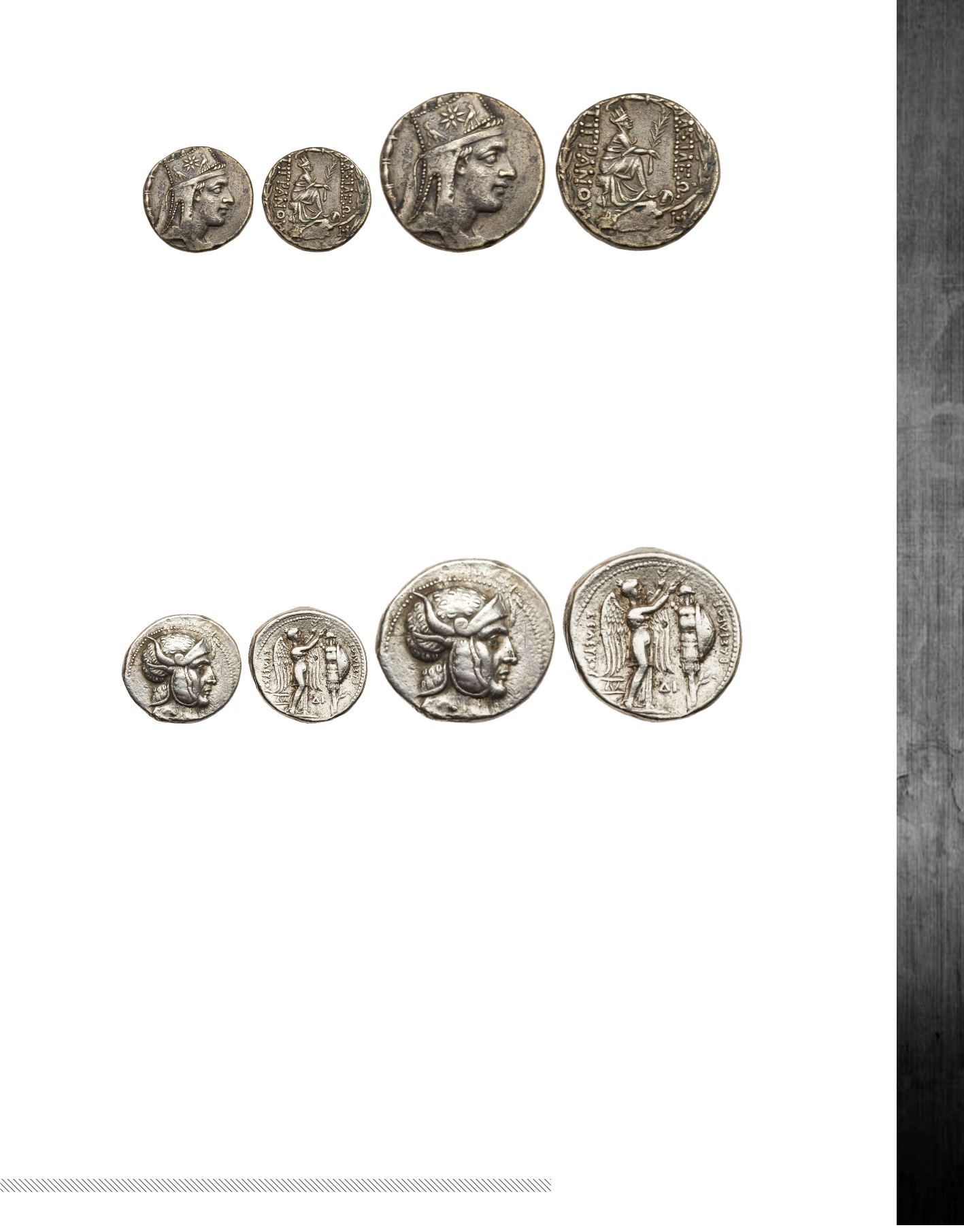

102
bid online at
www.goldbergcoins.com(800) 978-COIN (2646)
|
Ancient Coins
Enlargement
1762 Artaxiad Kingdom. Tigranes II ' the Great'. Silver Tetradrachm (15.31 g), 95-56 BC
. Tigranocerta, ca. 80-68 BC. Diademed and draped
bust of Tigranes II right, wearing tiara decorated with star between two eagles.
Reverse:
-
/
, Tyche seated right on rock,
holding laurel branch; below, river-god Orontes swimming right; on rock below,
monogram; all within wreath. SCADA grp. 7, obv. die A58;
ACCP 75.2; AC 33. Nicely toned.
Very Fine
.
Estimate Value ............................................................................................................................................................................ $800 - 900
The Hanbery Collection; Purchased privately from Rare Coins & Classical Arts in 1989.
Before ruling in the mountainous interior of Anatolia, Tigranes II spent many years as a hostage in the court of Mithradates II of Parthia. When he
was 40, Tigranes I died and Tigranes II was able to ' purchase' his freedom by ceding to Parthia a large part of Media Atropatene. Once on the
throne he quickly subdued the local barons of Armenia, who hitherto had paid only nominal submission to the king, thus centralizing his rule with
a tight grip. He then went on to invade his neighbors, expanding his kingdom in all directions at their expense. During the First Mithradatic War
between Mithradates VI of Pontos and Rome, Tigranes was careful to maintain the appearance of neutrality all the while secretly supporting
Mithradates. Subsequently, however, he allied with Pontos overtly, marrying Mithradates' daughter, Cleopatra, and sheltering Mithradates when he
had been defeated by Rome. This, of course, brought Armenia into direct conflict with Rome, and in two engagements with Lucullus, the Roman
consul in charge of pursuing the war against Mithradates, Tigranes was soundly defeated. Lucullus, however, was not successful in capturing
either Mithradates or Tigranes, and so after years of conducting an inconclusive war he was recalled to Rome and replaced by Pompey the Great.
Pompey was much more effective. He quickly brought Tigranes to heal, forcing him to give up the territories he had conquered during his long
reign in return for allowing him to remain on his throne.
Enlargement
1763 Seleukid Kingdom. Seleukos I Nikator. Silver Tetradrachm (16.74 g), 312-281 BC
. Susa, ca. 305/4-294 BC. Head of hero (Alexander or
Seleukos?) right, wearing helmet covered with panther' s skin and adorned with ear and horns of a bull.
Reverse:
, Nike
standing right, crowning trophy with wreath; below left wing, monogram; in field between Nike and trophy,
. SC 173.10; Kritt Tr.48; HGC 9, 20.
Rare. Choice Very Fine
.
Estimate Value .......................................................................................................................................................................$1,500 - 2,000
The Hanbery Collection; Purchased privately from F. Kovacs in 1993.
It is readily apparent that the reverse design of this coin showing Nike placing a wreath upon a trophy she has erected commemorates Seleukos'
recent victories in the Upper Satrapies and his assumption of the royal title in 305 BC. What is less certain is the identification of the head on the
obverse. Hadley argues for an assimilation of Alexander the Great with Dionysos, while Hoover sees a portrait of Seleukos himself, with the divine
attributes of Dionysos. For full discussion, see R. A. Hadley, "Seleucus, Dionysus, or Alexander?"
NC
1974, pp. 9-13, and Oliver D. Hoover, "The
identity of the helmeted head on the ' Victory' coinage of Susa,"
SNR
81, 2002, pp. 51-60.



















